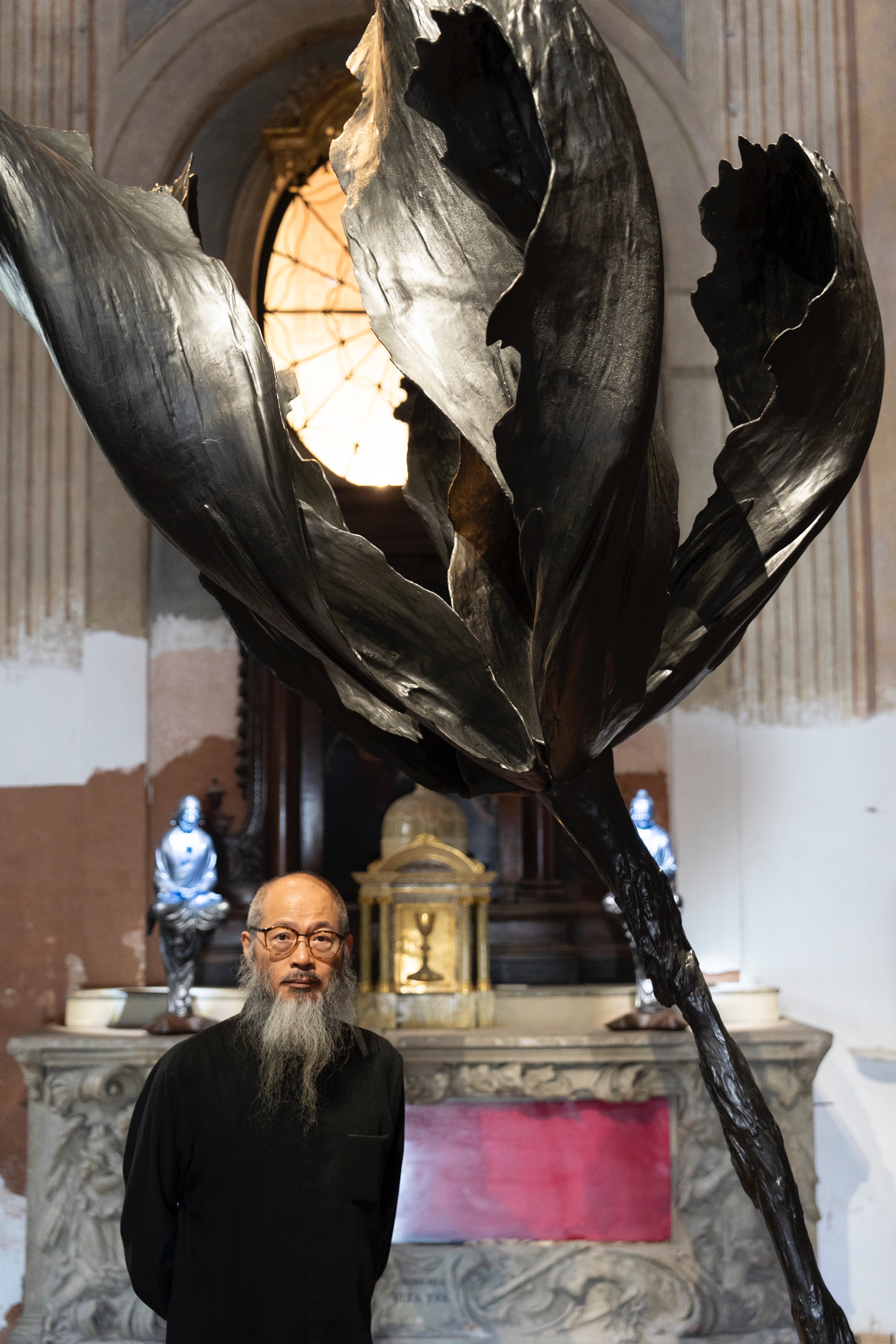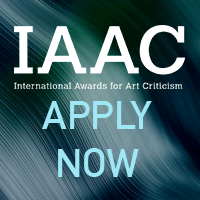Wallace Chan’s “Transcendence”
By Richard Vine
.jpg)
Portrait of WALLACE CHAN at his exhibition "Transcendence" at the Chiesa di Santa Maria dell Pieta, 2024, Venice. Photo by Federico Sutera. Courtesy the artist.
Apr 19–Sep 20, 2024
Wallace Chan
Transcendence
Chiesa di Santa Maria della Pietà
Venice
If you’ve ever uttered, or heard once too often, the modern mantra “I’m not religious, but I’m very spiritual,” Venice has a show for you. Wallace Chan, a Hong Kong-based artist known primarily for his innovative jewelry designs, created six figurative sculptures for an exhibition titled “Transcendence” at the 18th-century Chiesa di Santa Maria della Pietà on the waterfront near the Palazzo Ducale. The exhibition offered a chance to plumb what the benign-sounding “spiritual” credo might mean today.
“Transcendence” is the third in Chan’s series of Venetian solos, preceded by “Titans: A Dialogue Between Materials, Space, and Time” in 2021, which featured large works merging titanium faces with steel geometric forms, and “Totem” (2022), a deconstructed version of the same elements. British independent curator James Putnam has overseen all three installations, the first two of which were mounted at the 15th-century Fondaco Marcello, a former warehouse on the Grand Canal.
The venue change—from a site of commerce to a prominent religious space—is thematically telling. Chan, who is not formally trained as an artist, first encountered statues of saints and angels as a boy visiting Christian cemeteries. Born in Fuzhou in 1956, he experienced an impoverished youth in Hong Kong and was sent by his mother to seek food charity at churches and temples. Today he is a practicing Buddhist who once purged his earthly possessions and spent six months as a monk. In addition to his spectacular success as a jewelry designer (with examples in the British Museum and others on sale at TEFAF and Christie’s), he devotes a large portion of his time to producing artworks meant to engender contemplation and spiritual elevation.
.jpg)
WALLACE CHAN, Transcendence III, 2023, titanium, 116.5 × 79 × 195 cm. Courtesy the artist.
.jpg)
Installation view of WALLACE CHAN’s "Transcendence" at the Chiesa di Santa Maria dell Pieta, 2024, Venice. Photo by Federico Sutera. Courtesy the artist.
That is not to say that his works are anodyne—far from it. One could argue, indeed, that faith exists to wrestle with terror. Appropriately, then, even the setting for Chan’s show is spooky. The chapel is dark, high, and narrow—and vaguely ominous in its nearly total lack of hallowed décor and artifacts. That void, an absence seemingly foreshadowing the disappearance of Catholicism from the earth, recalls poet Philip Larkin’s stark musings on a near future “when churches fall completely out of use.” What would we do? Fill the architectural ruins with a substitute, Chan proposes, an amorphous spirituality that, though a little intimidating at first, deceptively seems to demand nothing and offends no one.
In the dim interior, the artist has suspended a single file of oozing, hollow, bluish-black visages, one solitary and the others clustered into two clumps, each work about the size of a hanging human body. Behind them a giant sculptural tulip blossoms from the floor, its stem studded with tiny anguished faces. Finally, at the rear, two seated figurines rest on an altar. Both sit with a straight-backed, cross-legged posture, one with hands in the Dhyani Mudra pose (signifying contemplation), the other forming the Anjali Mudra (respect, receptiveness, peace). Although both bodies are Buddhist in garb and disposition, one figure has the head of Jesus, despite the Buddhist swastika hovering over his heart, while the other has a long-eared Buddha head but the Christian heart-cross at his chest. The suggestion is that both religions—and, by extension, all religions—are, in essence, the same.
Chan’s parable of salvation is structured like a three-act play. First there is the Vale of Tears, where giant, perhaps anamorphic, faces lament Christian worldliness or Buddhist samsara. Then comes the rising hope of the tulip, a blooming of spiritual awareness that subsumes all those earthly trials and tribulations attested by the smaller faces stuck in its stem. Finally, the pilgrim attains inner peace, a transcendence like unto Christ’s or the Buddha’s, represented by the prophets’ modest but sublime meditative figures. Thus, leaving strife behind, we attain the Kingdom of God or the plane of Nirvana.
.jpg)
Installation view of WALLACE CHAN’s "Transcendence" at the Chiesa di Santa Maria dell Pieta, 2024, Venice. Photo by Federico Sutera. Courtesy the artist.
Chan, in his work and in conversation, gives every indication of being an earnest, well-meaning spiritual seeker. His contemporary middle-class version of divine striving is not the ancient soul-rending Buddhism of Bardo, Naraka, Yama, and myriad demons, nor the Christianity of Golgotha, self-flagellation, and a final judgment before God Almighty. The flaw in Chan’s roadmap to redemption lies not in the manifest intent of his art but in its latent, unexamined moral implications.
Transcendence has been a powerful artistic theme forever, from tribal masks to figurative masterpieces from the Age of Faith to modernist abstractions by Hilma af Klint, Wassily Kandinsky, Kazimir Malevich, Mark Rothko, and other lost souls. Chan deflects any questions regarding a specific religion and brushes off art historical queries in order to dwell on his universalist conviction and his technical accomplishments. By not hitching his art project to any one major religion, he avoids the historical record of how that belief system has affected believers and non-believers alike. Yet more disturbing is the realization that “transcendence” is not the saving alternative to this brutal perversion, but its root cause. Why? Because the moment some blissful state beyond the world becomes more important than the world itself and the people in it, all is lost.
Adherents will argue it is not religion that is at fault, but the misinterpretation and misapplication of religion by sinful mortals and heedless fanatics. But there comes a moment, after myriad successive disasters, when one must question the Sacred Word itself—be it the New Testament, the Vedas, the sutras, the Koran, or Das Kapital—in order to find therein the systemic error. Call it the last temptation: the fatal lure of transcendence. To esteem spiritual transport over daily, imperfect, exasperating human engagement is already a form of fanaticism—a disavowal of the world as it really functions and human beings as they really are.
Granted, life is tough. Why deny Chan—or Baudelaire, or anyone—their solace “anywhere out of this world”? Because that solace comes at the expense of others. Transcendence entails no duty—personal or institutional—to be empathetic, honest, and charitable. These are obligations, no matter how routinely violated, that conventional religion, for all its horrors, has in its favor. Indeed, it is the longing for transcendence that spoils religion for the rest of us—morally corrupting devotion by making it a pursuit of individual perfection, which is to say an individual escape from the splendid mess of dealing with our fellow human beings. It exempts acolytes not only from the rigors of applied religion but also from those of secular humanist “despair”—a realism that, renouncing any hope of a compensatory Heaven or transcendent asceticism, prompts us to treat each other with simple decency and compassion, here and now.
Venice visitors should thank Wallace Chan for this vital lesson, which he never intended to teach. God works in mysterious ways.
.jpg)
Installation view of WALLACE CHAN’s "Transcendence" at the Chiesa di Santa Maria dell Pieta, 2024, Venice. Photo by Federico Sutera. Courtesy the artist.
Richard Vine is the corresponding editor at ArtAsiaPacific.







